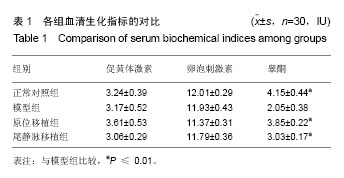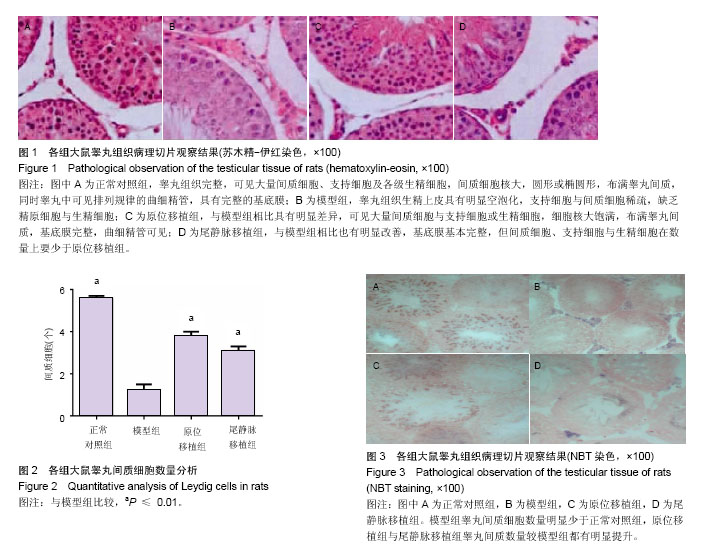中国组织工程研究 ›› 2017, Vol. 21 ›› Issue (1): 66-70.doi: 10.3969/j.issn.2095-4344.2017.01.012
• 干细胞移植 stem cell transplantation • 上一篇 下一篇
骨髓间充质干细胞移植对睾丸间质细胞再生及睾酮分泌的影响
刘明锴,杨文增,马 涛,魏若晶
- 河北大学附属医院泌尿外科,河北省保定市 071000
Effects of bone marrow mesenchymal stem cell transplantation on proliferation of testicular interstitial cells and secretion of testosterone
Liu Ming-kai, Yang Wen-zeng, Ma Tao, Wei Nuo-jing
- Department of Urinary Surgery, Affiliated Hospital of Hebei University, Baoding 071000, Hebei Province, China
摘要:
文章快速阅读:
.jpg)
文题释义: 雄性激素部分性缺乏综合征:是指随着老年男性年龄的增加,雄性激素水平不断下降,血清中睾酮水平低于一般健康男性的正常范围,并出现一系列与雄性激素部分缺乏相关的临床症状及体征的一组综合征。 骨髓间充质干细胞移植:是近年来兴起的一种新型治疗手段,具有取材容易、能迅速体外培育与增殖、具有多向分化潜能等优点,使其在细胞移植、组织工程、基因治疗等方面具有广阔前景。在临床应用中,骨髓间质干细胞移植被广泛应用于糖尿病、心肌梗死、脑出血、股骨头缺血性坏死、脑梗死、中枢神经系统损伤等疾病,而在男性性功能及激素水平方面的研究则鲜有报道。
摘要 背景:干细胞移植治疗雄性激素部分性缺乏综合征鲜有报道。 目的:观察骨髓间充质干细胞移植对老年大鼠性激素水平及睾丸组织的影响。 方法:取30只6月龄SD大鼠作为正常对照组,检测血清睾酮和游离睾酮浓度;选择血清睾酮和游离睾酮浓度低于正常对照组的90只20月龄SD大鼠,作为雄性激素部分性缺乏综合征模型,随机分为3组,模型组、原位移植组与尾静脉移植组,原位移植组在睾丸内注射2×108 L-1的骨髓间充质干细胞悬液0.2 mL,尾静脉移植组经尾静脉注射2×108 L-1的骨髓间充质干细胞悬液0.5 mL。移植8周后,检测各组血清中卵泡刺激素、促黄体激素及睾酮水平,并制作睾丸组织病理切片,观察睾丸组织及间质细胞情况。 结果与结论:①血清检测结果:4组间卵泡刺激素、促黄体激素水平比较差异均无显著性意义;模型组睾酮水平明显低于正常对照组(P ≤ 0.01),原位移植组、尾静脉移植组睾酮水平明显高于模型组(P ≤ 0.01);②苏木精-伊红染色结果:正常对照组睾丸组织完整,可见大量间质细胞、支持细胞及各级生精细胞;模型组睾丸组织缺失,支持细胞与间质细胞稀疏,缺乏精原细胞与生精细胞;原位移植组、尾静脉移植组睾丸组织较完整,可见大量间质细胞与支持细胞或生精细胞;③NBT染色结果:模型组睾丸间质细胞数量明显少于正常对照组(P ≤ 0.01),原位移植组、尾静脉移植组睾丸间质细胞数量明显多于模型组(P ≤ 0.01);④结果表明:骨髓间充质干细胞移植对老年大鼠睾丸组织有修复作用。
中国组织工程研究杂志出版内容重点:干细胞;骨髓干细胞;造血干细胞;脂肪干细胞;肿瘤干细胞;胚胎干细胞;脐带脐血干细胞;干细胞诱导;干细胞分化;组织工程 ORCID: 0000-0001-5658-8681(刘明锴)
中图分类号:


.jpg)